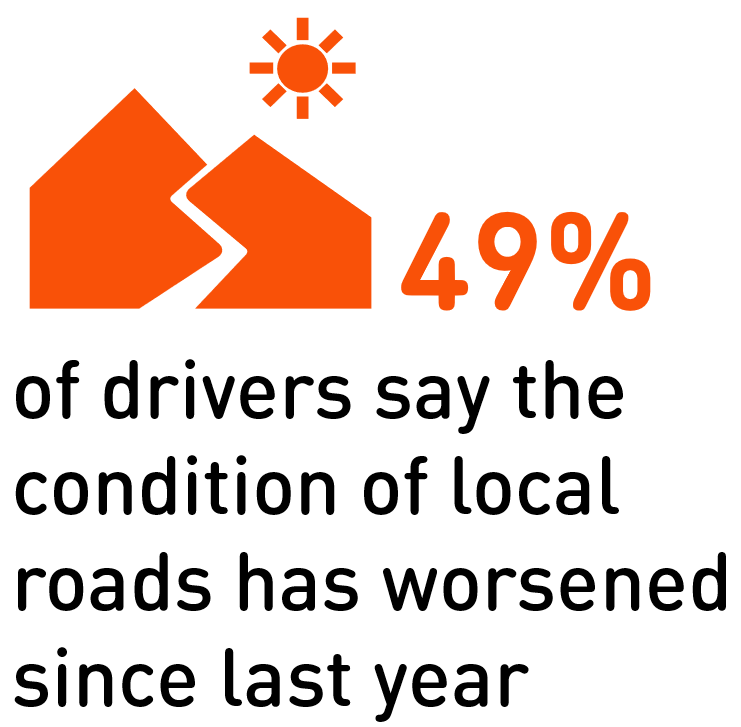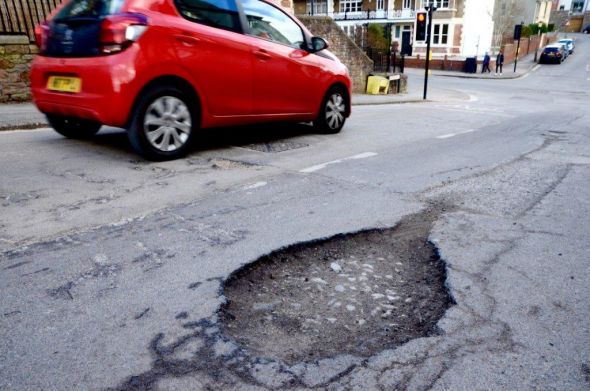The 2019 Report on Motoring shows that 49% of drivers say the condition of local roads – that is all roads that are not motorways or major A-roads – have deteriorated since last year, primarily as a result of potholes and other road-surface problems. Meanwhile only 11% believe the roads in their area have improved.

But while the picture is certainly gloomy, there are some indications that this issue is not as bad as it has been in recent years.
In 2018, for example, the condition of local roads was the top overall motoring-related concern for a staggering 17% of drivers – equating to roughly 6.8 million people – outstripping issues such as handheld mobile phone use, drink-driving and the cost of fuel. This year, however, that proportion has dropped to 10%.
There has also been a notable fall in the percentage of motorists who think local roads have got worse – in 2018, the proportion was 66% compared with this year’s 49%.
These figures chime with the RAC’s recent Pothole Index findings: these show that RAC patrols attended fewer pothole-related breakdowns in the first three months of 2019 than in any first quarter for three years, and also that in the 12 months to June this year, there were fewer such breakdowns than in any period since 2007.
The most recent edition of the annual survey carried out by the Asphalt Industry Alliance (AIA) echoes the Report on Motoring’s findings to some extent: the AIA’s 2019 Annual Local Authority Road Maintenance (ALARM) report, which was published in March, indicated that an increase in local authority funding was to some extent “stemming the decline” in the condition of England’s local roads.
Not just potholes
Potholes and related road-surface problems take most of the blame for worsening conditions. But these are not drivers’ sole concerns. There has been a sharp rise in dissatisfaction about grass and foliage maintenance on local roadsides, with 22% of drivers saying this is one reason conditions are worse.
At the same time, there has been a doubling in the proportion of motorists who say signage visibility on local roads has deteriorated, from 8% to 17%. It is quite possible that the two issues are linked, with substandard foliage maintenance leading to an increase in signs being obscured by vegetation.
Our research has also identified a growing sense of resentment among motorists, most of whom pay hundreds of pounds annually in motoring taxes but who are forced to endure such poor conditions.
More than eight in 10 drivers – 83%, or the equivalent of 31 million people – say that the quality of roads should be better given the amount of tax they hand over to the Government every year.
Almost as many drivers (77%) favour having at least a chunk of their motoring taxes ring-fenced to fund local road maintenance.
In July 2019, the Parliamentary Transport Committee published a report calling for long-term funding solutions to enable local authorities to better maintain roads under their control. The RAC has welcomed this report, and urged the government to develop a five-year investment plan for local roads.
And there appears to be a clear town-versus-country divide in terms of road maintenance: drivers based in rural locations are almost 10% more likely to say their local road conditions have worsened in the past 12 months. Meanwhile, 25% of London-based motorists say conditions are in fact better this year, against the UK-wide average of 11%.
Motorways and major roads: a better picture?
Drivers’ views on motorway and major dual-carriageway conditions are somewhat brighter than on local roads, but there is still considerable room for improvement.
Well over twice as many motorists – 28% – think the conditions here have worsened over the past 12 months as think they have improved (11%).
But this is less damning a verdict than in 2018, when 40% of drivers said the state of major roads had deteriorated.
Unfortunately, though, this year there has been a sharp increase in the number of motorists bemoaning the amount of litter by the side of major roads: 30% of those drivers who said motorway and A-road conditions had worsened blamed litter, up from 25% last year.
Finally, there is widespread support among motorists for the Government’s plans to use all money collected from Vehicle Excise Duty for the new National Roads Fund: 72% think this is a good idea.
From 2020-21, vehicle excise duty (VED) receipts will be ringfenced for use on strategic and major routes to increase capacity on the network to future-proof anticipated increased traffic volumes. The strategic road network presently carries around a third of all traffic while making up just 2% of all roads.
Experts’ views

The focus on improving the surface of our roads is to be welcomed but is there the possibility that the likes of Highways England are focusing on them a little too much at the detriment of other things? Motorists have major concerns over things like litter and signage visibility which get little attention."
Graeme Paton, Transport Correspondent, The Times

After a relatively mild winter it is no surprise that pothole problems are easing in comparison with last year – and that pothole repairs made in recent months are holding up.”
Steve Gooding, Director, RAC Foundation






